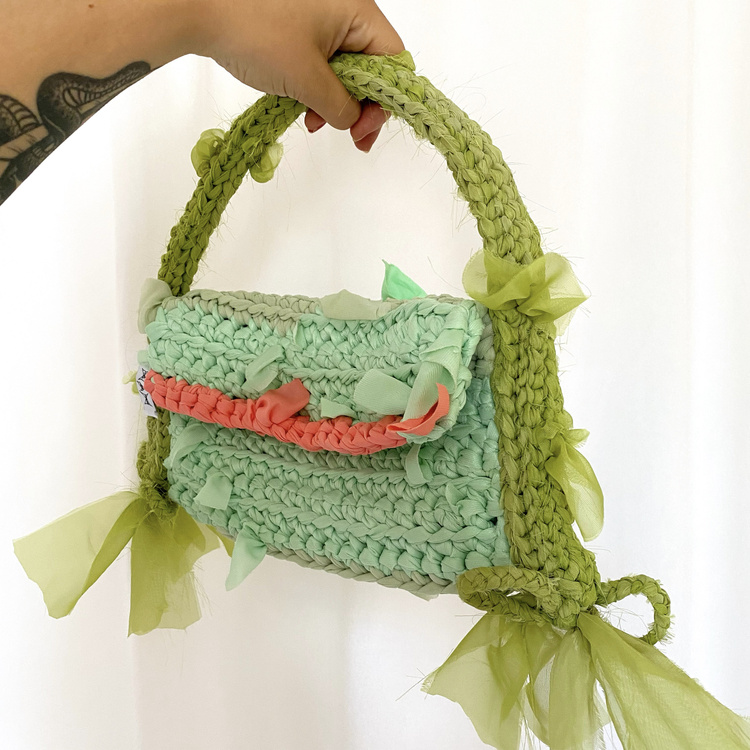When taking a closer look, it quickly becomes evident that the art world is not all sunshine and rainbows when it comes to sustainability. From the use of toxic and environmentally unfriendly materials such as glitter and paint to the amount of waste generated, art comes at a cost that is unwillingly paid by Mother Earth.
Far too familiar with this issue is knitting/crocheting enthusiast and artist Hepzibah Lyon. After graduating from the Camberwell College of Arts, Lyon says that she was left with an excess of leftover yarn and also needed to do something with her large-scale yarn artworks that “had become redundant outside of a studio context.”
With all the time in the world thanks to the COVID-19 lockdowns, Lyon recycled her yarn artworks and began crocheting Instagram-worthy handbags. A brand called HVML was then formed and since then, her handbags have caught the eye of influencers and the fashion industry as a whole.
Setting Mind interviews Lyon to learn more.
Setting Mind: Why did you decide to create your own brand “HVML”?
Lyon: I have always taken a huge pleasure in knitting and crochet… I think I always knew I would find a job somewhere within the arts but it has been a real dream come true building my brand.
I don’t think there was a specific point where I made any decision to form HVML … the brand actually came about quite naturally, after having some of my bags so well received I knew it was the right move for me.

What does HVML stand for?
HVML is actually my initials (Hepzibah Violet Marigold Lyon) … I really wanted my name on my work but my name is way too long ahaha. I think having the initials keeps it short and sweet.
Why create bags? Why not shirts or hats?
I never made any specific decision to focus on bags… I prefer to work without too many preconceived ideas so the bags just came about naturally when I sat down and started dismantling my old artworks.
Since then I have to say I do really love creating bags, exploring new shapes and creating new structures really satisfies me. I think in creating a bag there are potentially less boundaries than with an item such as a shirt; that said I do intend to broaden my design horizons soon.
I am lucky enough to have access to some really lovely sheep fleeces from an organic and ethical farm where my parents live in Italy, so this summer I will start the process of washing and hopefully dying too. The wool once processed will be used for some new clothing designs.
Why is it important to use recycled materials and factory ends for your products?
My biggest reason for working with recycled materials is obviously the environmental factor. The fashion industry is a huge contributor to global warming and I think for me as a new emerging designer I feel a responsibility to build something ethical and sustainable.
With all the textile waste produced every year, it’s actually a lot easier to work with recycled materials and factory ends. I always make sure to speak to suppliers before purchasing recycled yarns but also I have been extremely lucky with people gifting me old fabrics and leathers too!
As I just mentioned though I will soon be introducing wool into my collections… but this wool is 100% ethical (I think sometimes people assume all wool is good because wool is obviously a sustainable material however its best to check where your wool is coming from as some wools can still be unethical due to the treatment of the animal.)
It says on your website that you bought three sheep? That’s kinda awesome. The first question is why? Also, what are their names and how do you care for them?
Ahahah so I did purchase three sheep. My parents relocated a few years ago to Italy and are lucky enough to have a little bit of land out there…so when I was making plans for the brand they kindly offered to purchase me some sheep so that l could start learning how to process and treat wool on a small scale.
I was brought up with a lot of animals including an adopted sheep named Sean so my parents are very well equipped to take care of them. Also as I said, purchasing wool can sometimes be a little tricky in terms of its origin or the way the animal was raised.
There is also the issue that purchasing wool that is truly ethical can be very expensive so we thought three sheep could get me set up producing my own yarn independently and it would mean I could really guarantee my wool would be ethical.
Anyway, the story gets a little funny because in Italy sheep are able to roam around in a very different way to what we had experienced in the UK so Teresa, Gia and Maria (my girls) kept escaping out of their field and trying to sneak into my parent’s neighbours allotments. But the story didn’t end badly at all. Gia, Maria and Teresa now live back on their farm up in the mountains where they roam around without any fences or neighbour restrictions and I can visit them whenever I wish and still receive their fleeces!

Final question is where do you see HVML in the future?
I see HVML starting to make clothing using my wool, I see HVML creating some limited edition lines using new materials and designs but I am quite happy moving slowly and focusing on learning about and becoming more self-sufficient in terms of producing the textiles I use.
To learn more about Hepzibah Lyon’s brand, visit her Instagram and website.
This interview has been edited for length and clarity.
All images in this article are courtesy of HVML unless stated otherwise.








